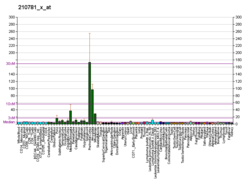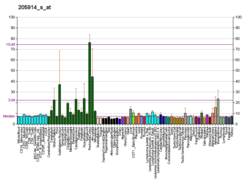Glutamate [NMDA] receptor subunit zeta-1 is a protein that in humans is encoded by the GRIN1 gene.[5][6]
The protein encoded by this gene is a critical subunit of N-methyl-D-aspartate receptors, members of the glutamate receptor channel superfamily which are heteromeric protein complexes with multiple subunits arranged to form a ligand-gated ion channel. These subunits play a key role in the plasticity of synapses, which is believed to underlie memory and learning. The gene consists of 21 exons and is alternatively spliced, producing transcript variants differing in the C-terminus. The sequence of exon 5 is identical in vertebrates, with exon 5 splicing demonstrated in human, mouse and rat.[7][8][9][10] Cell-specific factors are thought to control expression of different isoforms, possibly contributing to the functional diversity of the subunits.[6]
- ^ a b c GRCh38: Ensembl release 89: ENSG00000176884 – Ensembl, May 2017
- ^ a b c GRCm38: Ensembl release 89: ENSMUSG00000026959 – Ensembl, May 2017
- ^ "Human PubMed Reference:". National Center for Biotechnology Information, U.S. National Library of Medicine.
- ^ "Mouse PubMed Reference:". National Center for Biotechnology Information, U.S. National Library of Medicine.
- ^ Monyer H, Sprengel R, Schoepfer R, Herb A, Higuchi M, Lomeli H, et al. (May 1992). "Heteromeric NMDA receptors: molecular and functional distinction of subtypes". Science. 256 (5060): 1217–1221. Bibcode:1992Sci...256.1217M. doi:10.1126/science.256.5060.1217. PMID 1350383. S2CID 989677.
- ^ a b "Entrez Gene: GRIN1 glutamate receptor, ionotropic, N-methyl D-aspartate 1".
- ^ Sengar AS, Li H, Zhang W, Leung C, Ramani AK, Saw NM, et al. (December 2019). "Control of Long-Term Synaptic Potentiation and Learning by Alternative Splicing of the NMDA Receptor Subunit GluN1". Cell Reports. 29 (13): 4285–4294.e5. doi:10.1016/j.celrep.2019.11.087. PMID 31875540. S2CID 209482250.
- ^ Liu H, Wang H, Peterson M, Zhang W, Hou G, Zhang ZW (October 2019). "N-terminal alternative splicing of GluN1 regulates the maturation of excitatory synapses and seizure susceptibility". Proceedings of the National Academy of Sciences of the United States of America. 116 (42): 21207–21212. Bibcode:2019PNAS..11621207L. doi:10.1073/pnas.1905721116. PMC 6800312. PMID 31570583.
- ^ Herbrechter R, Hube N, Buchholz R, Reiner A (July 2021). "Splicing and editing of ionotropic glutamate receptors: a comprehensive analysis based on human RNA-Seq data". Cellular and Molecular Life Sciences. 78 (14): 5605–5630. doi:10.1007/s00018-021-03865-z. PMC 8257547. PMID 34100982.
- ^ Manta G, Spathis AD, Taraviras S, Kouvelas ED, Mitsacos A (August 2011). "Age and visual experience-dependent expression of NMDAR1 splice variants in rat retina". Neurochemical Research. 36 (8): 1417–1425. doi:10.1007/s11064-011-0467-5. PMID 21499738. S2CID 11853676.







